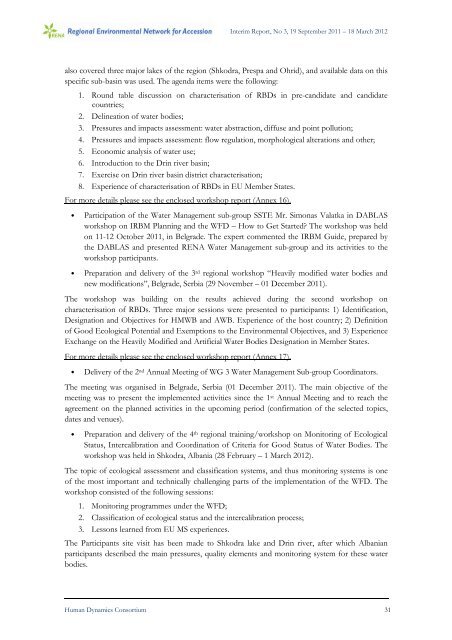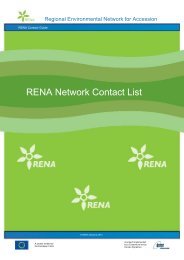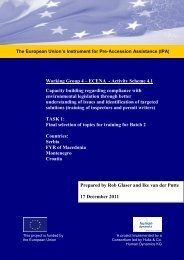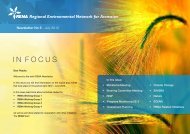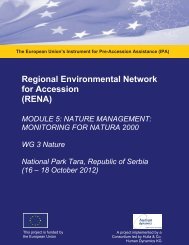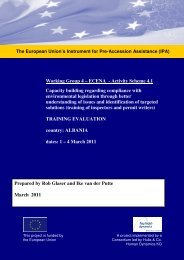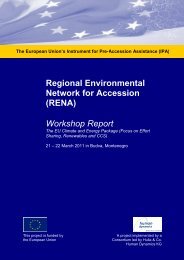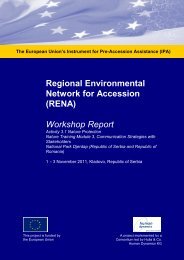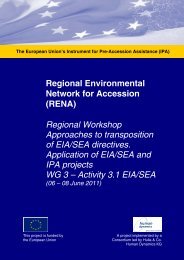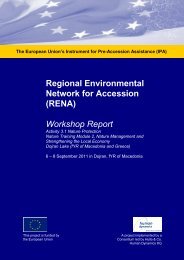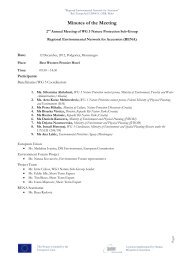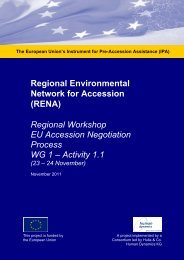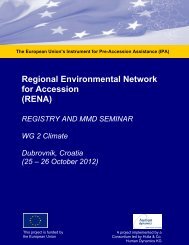3rd Interim report September 2011- March 2012.pdf - Renanetwork.org
3rd Interim report September 2011- March 2012.pdf - Renanetwork.org
3rd Interim report September 2011- March 2012.pdf - Renanetwork.org
Create successful ePaper yourself
Turn your PDF publications into a flip-book with our unique Google optimized e-Paper software.
<strong>Interim</strong> Report, No 3, 19 <strong>September</strong> <strong>2011</strong> – 18 <strong>March</strong> 2012<br />
also covered three major lakes of the region (Shkodra, Prespa and Ohrid), and available data on this<br />
specific sub-basin was used. The agenda items were the following:<br />
1. Round table discussion on characterisation of RBDs in pre-candidate and candidate<br />
countries;<br />
2. Delineation of water bodies;<br />
3. Pressures and impacts assessment: water abstraction, diffuse and point pollution;<br />
4. Pressures and impacts assessment: flow regulation, morphological alterations and other;<br />
5. Economic analysis of water use;<br />
6. Introduction to the Drin river basin;<br />
7. Exercise on Drin river basin district characterisation;<br />
8. Experience of characterisation of RBDs in EU Member States.<br />
For more details please see the enclosed workshop <strong>report</strong> (Annex 16).<br />
• Participation of the Water Management sub-group SSTE Mr. Simonas Valatka in DABLAS<br />
workshop on IRBM Planning and the WFD – How to Get Started The workshop was held<br />
on 11-12 October <strong>2011</strong>, in Belgrade. The expert commented the IRBM Guide, prepared by<br />
the DABLAS and presented RENA Water Management sub-group and its activities to the<br />
workshop participants.<br />
• Preparation and delivery of the 3 rd regional workshop “Heavily modified water bodies and<br />
new modifications”, Belgrade, Serbia (29 November – 01 December <strong>2011</strong>).<br />
The workshop was building on the results achieved during the second workshop on<br />
characterisation of RBDs. Three major sessions were presented to participants: 1) Identification,<br />
Designation and Objectives for HMWB and AWB. Experience of the host country; 2) Definition<br />
of Good Ecological Potential and Exemptions to the Environmental Objectives, and 3) Experience<br />
Exchange on the Heavily Modified and Artificial Water Bodies Designation in Member States.<br />
For more details please see the enclosed workshop <strong>report</strong> (Annex 17).<br />
• Delivery of the 2 nd Annual Meeting of WG 3 Water Management Sub-group Coordinators.<br />
The meeting was <strong>org</strong>anised in Belgrade, Serbia (01 December <strong>2011</strong>). The main objective of the<br />
meeting was to present the implemented activities since the 1 st Annual Meeting and to reach the<br />
agreement on the planned activities in the upcoming period (confirmation of the selected topics,<br />
dates and venues).<br />
• Preparation and delivery of the 4 th regional training/workshop on Monitoring of Ecological<br />
Status, Intercalibration and Coordination of Criteria for Good Status of Water Bodies. The<br />
workshop was held in Shkodra, Albania (28 February – 1 <strong>March</strong> 2012).<br />
The topic of ecological assessment and classification systems, and thus monitoring systems is one<br />
of the most important and technically challenging parts of the implementation of the WFD. The<br />
workshop consisted of the following sessions:<br />
1. Monitoring programmes under the WFD;<br />
2. Classification of ecological status and the intercalibration process;<br />
3. Lessons learned from EU MS experiences.<br />
The Participants site visit has been made to Shkodra lake and Drin river, after which Albanian<br />
participants described the main pressures, quality elements and monitoring system for these water<br />
bodies.<br />
Human Dynamics Consortium 31


